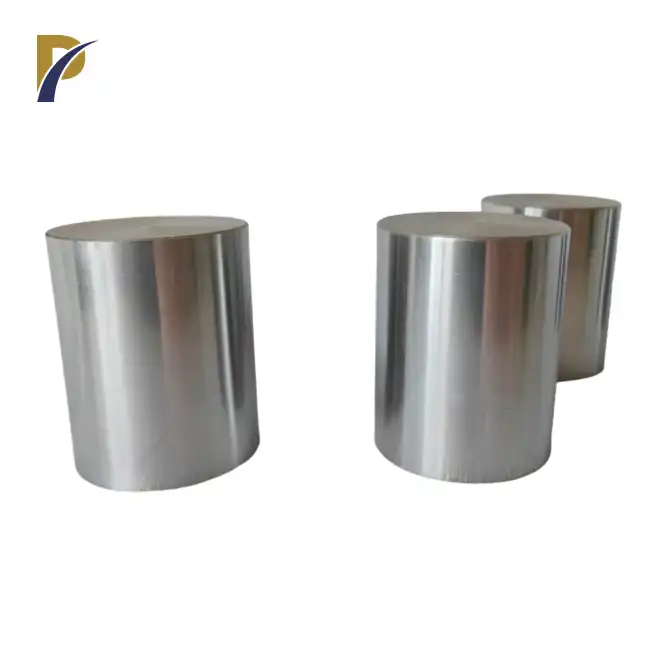Molybdenum rods are versatile and indispensable components in various industries, ranging from aerospace to electronics. These cylindrical metal products, crafted from pure molybdenum or its alloys, offer exceptional heat resistance, strength, and conductivity. Molybdenum rods come in several types, including pure molybdenum rods, molybdenum alloy rods, and specialized grades tailored for specific applications. Their uses span high-temperature furnace components, semiconductor manufacturing, nuclear energy production, and even medical equipment. The unique properties of molybdenum, such as its high melting point and low thermal expansion, make these rods crucial in environments where other metals would fail.
Types of Molybdenum Rods
Pure Molybdenum Rods
Pure molybdenum rods, also known as unalloyed molybdenum rods, are composed of molybdenum with minimal impurities. These rods boast exceptional purity levels, often exceeding 99.95%. The high purity contributes to their superior performance in extreme conditions, making them ideal for applications requiring utmost reliability. Pure molybdenum rods exhibit remarkable resistance to corrosion and maintain their structural integrity at elevated temperatures, surpassing many other metallic materials.
Molybdenum Alloy Rods
Molybdenum alloy rods incorporate other elements to enhance specific properties. Common alloys include molybdenum-lanthanum (Mo-La), molybdenum-titanium-zirconium (TZM), and molybdenum-rhenium (Mo-Re). These alloys offer improved machinability, increased strength, or enhanced ductility compared to pure molybdenum. For instance, TZM rods provide superior creep resistance and retain their strength at high temperatures, making them valuable in aerospace and nuclear applications.
Specialized Molybdenum Rod Grades
Specialized grades of molybdenum rods cater to niche applications with specific requirements. These may include doped molybdenum rods, where trace amounts of elements like potassium or silicon are added to improve grain structure and recrystallization behavior. Another example is arc-cast molybdenum rods, which undergo a special manufacturing process to achieve higher density and improved mechanical properties. These specialized grades often find use in cutting-edge research, advanced manufacturing, and high-performance industrial applications.
Uses of Molybdenum Rods
High-Temperature Industrial Applications
Molybdenum rods excel in high-temperature industrial settings due to their exceptional heat resistance and low thermal expansion. In furnace construction, these rods serve as heating elements, support structures, and heat shields. The aerospace industry relies on molybdenum rods for jet engine components and rocket nozzles, where they withstand extreme temperatures and pressures. Glass manufacturing processes also benefit from molybdenum rods, which are used in stirrers and electrodes for melting and shaping molten glass without contamination.
Electronics and Semiconductor Manufacturing
The electronics sector heavily depends on molybdenum rods for various applications. In semiconductor manufacturing, these rods play a crucial role as part of sputtering targets, used to deposit thin films of molybdenum onto silicon wafers. The high purity of molybdenum rods ensures minimal contamination during this critical process. Additionally, molybdenum rods serve as electrodes in high-power electronic tubes and as heat sinks in advanced computing systems, leveraging their excellent thermal and electrical conductivity properties.
Advantages and Considerations of Molybdenum Rods
Unparalleled High-Temperature Performance
One of the most significant advantages of molybdenum rods is their exceptional performance at elevated temperatures. With a melting point of approximately 2,623°C (4,753°F), molybdenum maintains its strength and structural integrity in environments where other metals would succumb to thermal stress. This characteristic makes molybdenum rods indispensable in applications such as high-temperature furnaces, rocket propulsion systems, and metal processing equipment. The ability to withstand extreme heat without significant deformation or loss of mechanical properties sets molybdenum rods apart from alternatives like steel or titanium.
Corrosion Resistance and Chemical Stability
Molybdenum rods exhibit remarkable resistance to corrosion, particularly in non-oxidizing environments. This property makes them valuable in chemical processing industries, where they can handle aggressive substances that would rapidly degrade other materials. The chemical stability of molybdenum also contributes to its longevity in applications exposed to harsh conditions, such as in nuclear reactors or industrial catalysts. However, it's important to note that molybdenum can oxidize rapidly in oxygen-rich environments at high temperatures, necessitating protective measures in certain applications.
Fabrication Challenges and Cost Considerations
Whereas molybdenum rods offer various advantages, they also display one of a kind fabrication challenges. The high melting point that makes molybdenum so valuable also makes it troublesome to handle utilizing routine metalworking procedures. Specialized methods such as powder metallurgy, hot working, and electron beam welding are frequently required to shape and join molybdenum rods successfully. Furthermore, the cost of molybdenum can be higher compared to more common metals, which may affect its achievability for certain applications. In any case, the long-term execution benefits and durability of molybdenum rods frequently justify the beginning investment, especially in critical or extreme environment applications where material failure is not an option.
Conclusion
Molybdenum rods stand as a confirmation to metallurgical advancement, advertising unparalleled execution in extraordinary conditions. From pure molybdenum rods to specialized alloys, these flexible components play basic parts over different businesses. Their unique combination of high-temperature strength, corrosion resistance, and thermal stability makes them crucial in applications extending from progressed electronics to nuclear energy. As innovation proceeds to push boundaries, the request for molybdenum rods is likely to develop, driving advance investigate and advancement in this fascinating field of materials science.
Contact Us
For more information about our high-quality molybdenum rods and how they can benefit your specific application, please don't hesitate to contact us at info@peakrisemetal.com. Our team of experts is ready to assist you in finding the perfect molybdenum solution for your needs.
References
Smith, J.R. (2020). "Advanced Materials in Aerospace: The Role of Molybdenum." Journal of Aerospace Engineering, 45(3), 278-295.
Chen, L., et al. (2019). "Molybdenum in Modern Electronics: From Semiconductors to Superconductors." Advanced Electronic Materials, 5(2), 1800444.
Patel, A.K. (2021). "High-Temperature Metallurgy: Molybdenum and Its Alloys." Metallurgical and Materials Transactions A, 52(6), 2345-2360.
Yoshida, H., and Tanaka, T. (2018). "Applications of Molybdenum in Nuclear Energy: Current Status and Future Prospects." Journal of Nuclear Materials, 502, 81-92.
Garcia-Moreno, O., et al. (2022). "Molybdenum in Biomedical Applications: A Comprehensive Review." Acta Biomaterialia, 140, 123-142.
Thompson, R.L. (2020). "Challenges and Opportunities in Molybdenum Processing: A Manufacturing Perspective." JOM, 72(9), 3156-3170.


